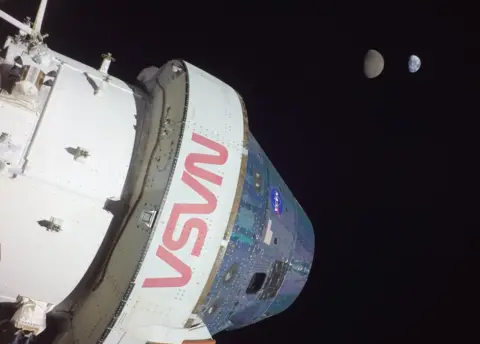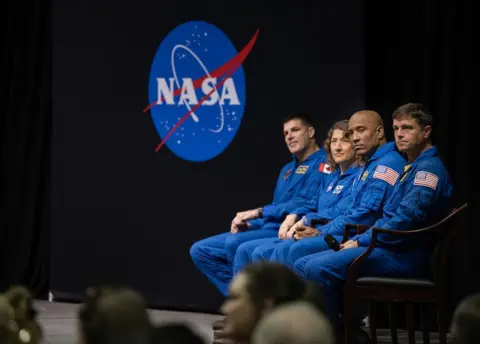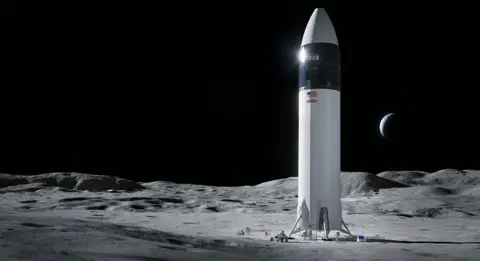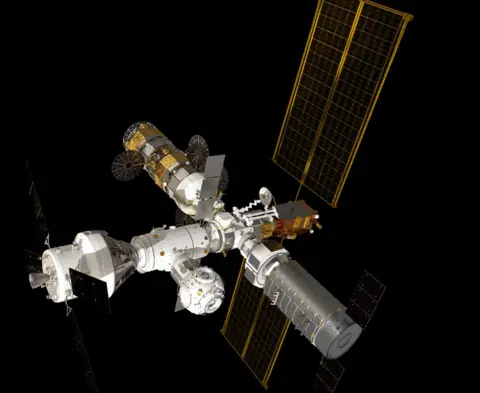Artemis: Nasa delays crewed return to the Moon's surface

 NASA
NASAUS space agency astronauts won't get to walk on the Moon again until September 2026 at the earliest.
It represents a slip of a year in the previously targeted date for the return of humans to the lunar surface that was last achieved in 1972.
Nasa says the delay to what's known as its Artemis III mission will enable further technology development.
Fundamentally, the agency still doesn't have a craft to put astronauts on the Moon or spacesuits they can wear.
Announcing the delay, agency administrator Bill Nelson said safety drove all timing considerations. "We won't fly until we're ready," he told reporters.
 NASA
NASANasa is also pushing back to September 2025 the precursor mission known as Artemis II. This will see four astronauts fly around the Moon without actually landing. Until today, this flight was in the calendar for the end of this year.
A crew comprising Jeremy Hansen, Christina Koch, Victor Glover and Reid Wiseman are already in training.
Artemis I occurred in November 2022. This was an uncrewed demonstration of the SLS rocket and Orion capsule that Nasa will use to get astronauts to lunar orbit. But the capsule now requires the installation of a life-support system before the Artemis II quartet can climb aboard and the space agency says there are concerns about the electronics in this system that will now have to be revised.
Engineers also want more time to understand the behaviour and performance of the heatshield that protects the Orion capsule during the fiery re-entry into Earth's atmosphere at the end of a mission. This shield experienced some unexpected losses of material during the Artemis I return.
But Nasa's biggest issue going forwards is probably the landing craft for Artemis III.
 SpaceX
SpaceXThis will be supplied by entrepreneur Elon Musk's SpaceX company and it will be a version of the huge new Starship vehicle currently being tested in Texas.
The idea is for astronauts to transfer to Starship in lunar orbit and then go down in it to the Moon's surface.
SpaceX needs not only to get the new vehicle working properly but also to stage an uncrewed demonstration at the Moon. And just getting Starship to the vicinity of the Moon will require the company to refuel its craft in Earth orbit first - a practice that's completely novel.
Indeed, it could take 10 launches, or more, of other Starships just to get enough fuel into one vehicle above the Earth so it can make the journey to the Moon and then perform a landing.
 Mark Felix/Getty
Mark Felix/GettyNasa associate administrator Jim Free was asked if it was realistic to think all this technology could be perfected by September 2026.
"We're setting a date for [Artemis III] that we have set with our contractors, based on the technical plans that they've laid out," he responded. "What I can tell you is we put margin in there to account for some of the risks that we anticipate seeing. We've tried to address the unknown unknowns and set a realistic plan in place."
Dates not slipping currently are those for the Artemis IV and V missions, which are set to take place in 2028 and 2029 respectively.
IV will see the first astronaut flight to the new Gateway lunar space station that will be constructed this decade. V will see the introduction of a second landing system called Blue Moon. This is being developed by the space company owned by Amazon.com founder Jeff Bezos.
 ESA
ESA